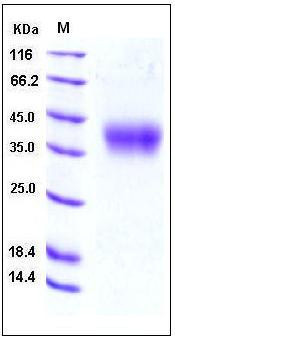Mouse 4-1BBL / CD137L / TNFSF9 Protein (His Tag)
4-1BB-L,4-1BBL,AI848817,Cd137l,Ly63l
- 100ug (NPP1034) Please inquiry
| Catalog Number | P50067-M07H |
|---|---|
| Organism Species | Mouse |
| Host | Human Cells |
| Synonyms | 4-1BB-L,4-1BBL,AI848817,Cd137l,Ly63l |
| Molecular Weight | The secreted recombinant mouse TNFSF9 consists of 222 amino acids and has a calculated molecular mass of 25 kDa. As a result of glycosylation, the recombinant protein migrates as an approximately 40-45 kDa protein in SDS-PAGE under reducing conditions. |
| predicted N | His |
| SDS-PAGE |  |
| Purity | > 97 % as determined by SDS-PAGE |
| Protein Construction | A DNA sequence encoding the extracellular domain (Arg 104-Glu 309) of mouse TNFSF9 (NP_033430.1) precursor was expressed with a N-terminal polyhistidine tag. |
| Bio-activity | Measured by its binding ability in a functional ELISA . Immobilized recombinant mouse 4-1BB Ligand at 20 μg/ml (100ul/well) can bind human 4-1BB with a linear range of 15.6-500 ng/ml . |
| Research Area | Cancer |Cancer immunology |Cytokine & Receptor |Tumor Necrosis Factor (TNF) & Receptor |TNF Receptor |
| Formulation | Lyophilized from sterile PBS, pH 7.4 1. Normally 5 % - 8 % trehalose, mannitol and 0.01% Tween80 are added as protectants before lyophilization. Specific concentrations are included in the hardcopy of COA. |
| Background | 4-1BBL is the high affinity ligand of 4-1BB, also known as CD137L or TNFSF9. It is shown to be a type II surface glycoprotein belonging to the TNF superfamily. Expression of 4-1BBL is restricted to APCs, such as dendritic cells, macrophages, and activated B cells. Members of the TNF-TNF receptor superfamily have been shown to play critical roles in regulating cellular activation, differentiation and apoptosis. Several studies have reported that 4-1BBL/4-1BB interaction provided a co-stimulatory signal to T cells, and increased T cell proliferation and cytokines production. In additon, 4-1BBL is involved in cancers, infectious diseases and autoimmune diseases. |
| Reference |
